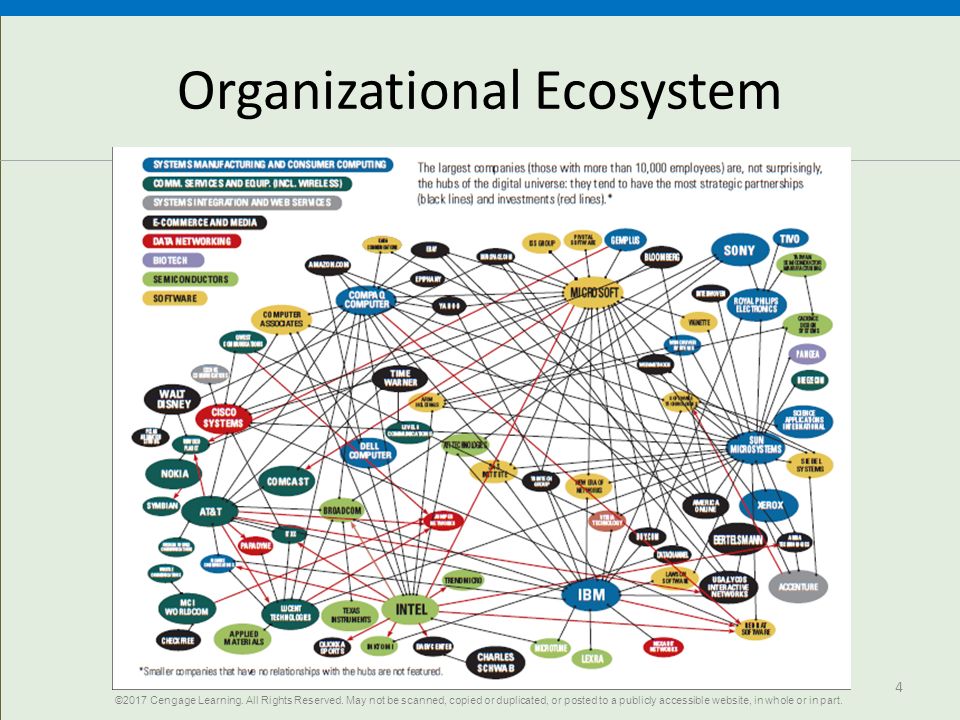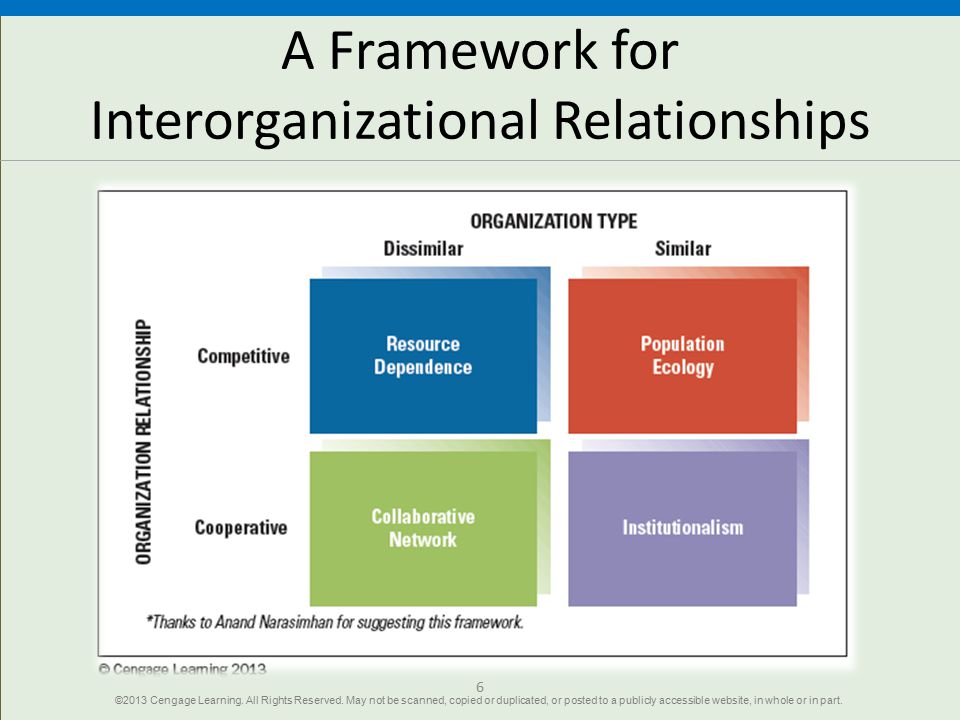Interorganizational Relationships
Today’s organizations encounter numerous complex problems of the complexity and uncertainty of the environment. Thus, a widespread organizational trend is to reduce separation and increase collaboration between companies, sometimes even between competitors.
Apple and Google compete fiercely in some areas, but they teamed up for Apple to use the Google Cloud platformOpens in new window as part of the infrastructure for Apple’s iCloudOpens in new window storage service.
In many industries, the business environment is so complicated that no single company can develop all the expertise and resources needed to stay competitive. Why?
GlobalizationOpens in new window and rapid advances in technology, communications, and transportation have created amazing new opportunities, but they also raised the cost of doing business and made it increasingly difficult for any company to take advantage of those opportunities on its own.
In this new economy, webs of organizations are emerging. Collaboration and partnership is the new way of doing business. Organizations think of themselves as teams that create value jointly rather than as autonomous companies that are in competition with all others.
This topic series explore the most recent trend in organizing, which is the increasingly dense web of relationships among organizations. Companies have always been dependent on other organizations for supplies, materials, and information.
The question involves the way these relationships are managed. At one time it was a matter of a large, powerful company tightening the screws on small suppliers. Today a company can choose to develop positive, trusting relationships.
The notion of horizontal relationships and the understanding of environmental uncertainty are leading to the next stage of organization evolution, which is a web of horizontal relationships across organizations. OrganizationsOpens in new window can choose to build relationships in many ways, such as:
- appointing preferred suppliers,
- establishing agreements,
- business partnering,
- joint ventures, or even mergers and acquisitions.
Interorganizational research has yielded perspectives such as resource dependenceOpens in new window, collaborative networksOpens in new window, population ecologyOpens in new window, and institutionalism.
The sum total of these ideas can be daunting because it means managers no longer can rest in the safety of managing a single organization. They have to figure out how to manage a whole set of interorganizatonal relationships, which is a great deal more challenging and complex.
Organizational Ecosystems
Interorganizational relationships are the relatively enduring resource transactions, flows, and linkages that occur among two or more organizations.
Traditionally, these transactions and relationships have been seen as a necessary evil to obtain what an organization needs.
The presumption has been that the world is composed of distinct businesses that thrive on autonomy and compete for supremacy. A company may be forced into interorganizational relationships depending on its needs and the instability and complexity of the environment.
A new view described by James Moore argues that organizations are now evolving into business ecosystems.
An organizational ecosystem is a system formed by the interaction of a community of organizations and their environment.
An ecosystem cuts across traditional industry lines. For example, wireless service providers, handset manufacturers, makers of computer chips and other hardware, operating system and software providers, and applications developers are involved in an ecosystem for smartphones.
A similar concept is the megacommunity approach, in which businesses, governments, and nonprofit organizations join together across sectors and industries to tackle huge, compelling problems of mutual interest, such as energy development, world hunger, or cybercrime.
Is Competition Dead?
No company can go it alone under a constant onslaught of interpersonal competitors, changing technology, and new regulations.
Organizations around the world are embedded in complex networks of confusing relationships—collaborating in some markets, competing fiercely in others. The U.S. retailer WalmartOpens in new window and Japan’s large e-commerce business RakutenOpens in new window formed a strategic alliance to help both companies better compete against Amazon.
In the auto industry, FordOpens in new window and VolkswagenOpens in new window have joined together in the production of pickup trucks and delivery vans that the two companies will sell under their own names in South America, Africa, and Europe, and they are discussing ways to share innovations in the development of electric and self-driving cars.
Traditional competition, which assumes a distinct company competing for survival and supremacy with other stand-alone businesses, no longer exists because each organization both supports and depends on the others for success, and perhaps for survival.
However, most managers recognize that the competitive stakes are higher than ever in a world where market share can crumble overnight, and no industry is immune from almost instant obsolescence. In today’s world, a new form of competition is in fact intensifying.
For one thing, companies now need to co-evolve with others in the ecosystem so that everyone gets stronger. Consider the wolf and the caribouOpens in new window. Wolves cull weaker caribou, which strengthens the herd. A strong herd means that wolves must become stronger themselves.
With co-evolution, the whole system becomes stronger. In the same way, companies co-evolve through discussion with each other, shared visions, alliances, and managing complex relationships.
Figure X-1 illustrates the complexity of an ecosystem by showing the myriad overalapping relationships among companies involved in the development of self-driving and autonomous vehicles.
 Figure X-1 An Organizational Ecosystem | Credit — Slideplayer Opens in new window
Figure X-1 An Organizational Ecosystem | Credit — Slideplayer Opens in new window
|
Since the time this partnership map was created, some of the connections have changed. Ecosystems constantly change and evolve, with some relationships growing stronger while others weaken or are terminated.
The changing pattern of relationships and interactions in an ecosystem contributes to the health and vitality of the system as an integrated whole.
In an organizational ecosystem, conflict and cooperation exist at the same time. For example, consider the case of Apple and Samsung.
| IN PRACTICE | Apple and Samsung |
|---|
| Samsung is Apple’s most ferocious rival in the smartphone wars. The companies spent the better part of seven years suing and countersuing over the look, feel, and features of their phones before reaching an undisclosed settlement in mid-2018. Yet Samsung is also the biggest supplier of many key parts used in Apple’s iPhones and iPads, including OLED displays and DRAM chips. One report indicates that Samsung earns around $110 from each iPhoneX sold by Apple. When Apple first began collaborating with Samsung, the two companies didn’t really compete, but that changed when Samsung got into producing smartphones that today eclipse the iPhone in terms of units shipped. Apple managers have tried to find alternate suppliers for some of the parts it uses from Samsung, but it isn’t easy. The two firms have worked together for a decade to build custom chips, and Samsung is the only company producing the chips and OLED displays at the volume Apple needs. Apple executives realized Samsung had ambitions to compete with their company, but they needed the technology that only Samsung could deliver in large quantities. Samsung, meanwhile, needed the sales to Apple. Apple remains Samsung’s biggest customer. In early 2019, Apple and Samsung announced a partnership offering iTunes movies, TV shows, and other content on rival Samsung’s television sets, tying the two companies even closer. “These are two of the largest companies on the planet deeply tied at the hip and directly competitive,” said David Yoffle, a professor at Harvard Business School. “That makes this stand out compared with almost any relationship you can think of.” |
Some companies believe cooperation is essential to success. Google, for example, has a whole team dedicated to giving away technology to the competition. Other companies, such as Apple, are less willing to cooperate, although they do so when it clearly benefits them.
In general, cooperation has become the rule in many industries and especially in high-tech firms. The business press is full of articles that talk about frenemies and cooperation, reflecting the trend toward companies that long prided themselves on independence have shifted to an ecosystem approach.
Mutual dependencies and partnerships have become a fact of life. Is competition dead? Companies today may use their strength to achieve victory over competitors, but ultimately cooperation carries the day.
Interorganizational Framework
Appreciating the larger organizational ecosystem is one of the most exciting areas of organization theory. The models and perspectives for understanding interorganizational relationships ultimately help managers change their role from top-down management to horizontal coordination across organizations.
Figure X-2 shows a framework for analyzing the different views of interorganizational relationships.
 Figure X-2 A Framework of Organizational Relationships | Credit — Slideplayer Opens in new window
Figure X-2 A Framework of Organizational Relationships | Credit — Slideplayer Opens in new window
|
Relationships among organizations can be characterized by whether the organizations are dissimilar or similar and whether relationships are competitive or cooperative.
By understanding these perspectives, managers can assess their environment and adopt strategies to suit their needs.
- The first perspective is called resource-dependence theory, which describes rational ways organizations deal with each other to reduce their dependence on the environment.
- The second perspective is about collaborative networks, wherein organizations allow themselves to become dependent on other organizations to increase value and productivity for all.
- The third perspective is population ecology, which examines how new organizations fill niches left open by established organizations and how a rich variety of new organizational platforms benefits society.
- The final approach is called institutionalism, which explains why and how organizations legitimatize themselves in the larger environment and design structures by borrowing ideas from each other.
These four approaches to the study of interorganizational relationships are each described in designated posts (entries).
| Remember This! |
|---|
|
The series:
- Research data for this work have been adapted from the manual:
- Organization Theory & Design By Richard L. Daft

